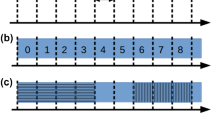Abstract
All-optical networks have been largely investigated due to their high data transmission rates. The key to the high speeds in all-optical networks is to maintain the signal in optical form, to avoid the overhead of conversion to and from electrical form at the intermediate nodes. In the traditional WDM technology the spectrum of light that can be transmitted through the optical fiber has been divided into frequency intervals of fixed width with a gap of unused frequencies between them. In this context the term wavelength refers to each of these predefined frequency intervals. An alternative architecture emerging in very recent studies is to move towards a flexible model in which the usable frequency intervals are of variable width. Every lightpath is assigned a frequency interval which remains fixed through all the links it traverses. Two different lightpaths using the same link have to be assigned disjoint sub-spectra. This technology is termed flex-grid or flex-spectrum. The introduction of this technology requires the generalization of many optimization problems that have been studied for the fixed-grid technology. Moreover it implies new problems that are irrelevant or trivial in the current technology. In this work we focus on bandwidth utilization in path toplogy and consider two wavelength assignment, or in graph theoretic terms coloring, problems where the goal is to maximize the total profit. We obtain bandwidth maximization as a special case.


Similar content being viewed by others
References
Gerstel, O.: Flexible use of spectrum and photonic grooming. In: Photonics in Switching, OSA (Optical Society of America) Technical Digest, page paper PMD3 (2010)
Ramaswami, R., Sivarajan, K.N., Sasaki, G.H.: Optical Networks: a Practical Perspective. Morgan Kaufmann Publisher Inc., San Francisco (2009)
Klasing, R.: Methods and problems of wavelength-routing in all-optical networks. In: Proceeding of the MFCS’98 Workshop on Communication, August 24–25, Brno, Czech Republic, pp. 1–9 (1998)
Jinno, M., Takara, H., Kozicki, B., Tsukishima, Y., Sone, Y., Matsuoka, S.: Spectrum-efficient and scalable elastic optical path network: architecture, benefits, and enabling technologies. Comm. Mag. 47, 66–73 (2009)
Gerstel, O.: Realistic approaches to scaling the IP network using optics. In: Optical Fiber Communication Conference and Exposition and the National Fiber Optic Engineers Conference (OFC/NFOEC), pp. 1–3 (2011)
Shachnai, H., Voloshin, A., Zaks, S.: Optimizing bandwidth allocation in flex-grid optical networks with application to scheduling. In: 2014 IEEE 28th International Parallel and Distributed Processing Symposium, Phoenix, AZ, USA, May 19–23, 2014, pp. 862–871 (2014)
Shachnai, H., Voloshin, A., Zaks, S.: Flexible bandwidth assignment with application to optical networks - (extended abstract). In: Mathematical Foundations of Computer Science 2014—39th International Symposium, MFCS 2014, Budapest, Hungary, August 25–29, 2014. Proceedings, Part II, pp. 613–624 (2014)
Golumbic, M.C.: Algorithmic Graph Theory and Perfect Graphs (Annals of Discrete Mathematics, Vol 57). North-Holland Publishing Co., Amsterdam (2004)
Garey, M., Johnson, D.S.: Computers and Intractability, A Guide to the Theory of NP-Completeness. Freeman, New York (1979)
Halldórson, M.M., Kortzarz, G.: Multicoloring: problems and techniques. In: 29th International Symposium on Mathematical Foundations of Computer Science, MFCS, LNCS 3153, pp. 25–41. Springer (2004)
Shalom, M.: On the interval chromatic number of proper interval graphs. Discret. Math. 338, 1907–1916 (2015)
Buchsbaum, A.L., Karloff, H., Kenyon, C., Reingold, N., Thorup, M.: Opt versus load in dynamic storage allocation. SIAM J. Comput. 33(3), 632–646 (2004)
Buchsbaum, A.L., Efrat, A., Jain, S., Venkatasubramanian, S., Yi, K.: Restricted strip covenring and the sensor cover problem. In: SODA ’07 Proceedings of the Eighteenth Annual ACM-SIAM Symposium on Discrete Algorithms, pp. 1056–1063 (2007)
Shalom, M., Wong, P.W.H., Zaks, S.: Profit maximizing colorings in flex-grid optical networks. In: Proceedings of the 20th International Colloquium on Structural Information and Communication Complexity (SIROCCO), Ischia, Italy, pp. 249–260 (2013)
Goldberg, A.V., Tarjan, R.E.: Finding minimum-cost circulations by canceling negative cycles. J. ACM 36(4), 873–886 (1989)
Author information
Authors and Affiliations
Corresponding author
Additional information
Publisher’s Note
Springer Nature remains neutral with regard to jurisdictional claims in published maps and institutional affiliations.
The work of this author Prudence W. H. Wong is supported by the initiative “Networks Sciences & Technologies (NeST) by School of EEE & CS, University of Liverpool”.
Rights and permissions
About this article
Cite this article
Shalom, M., Wong, P.W.H. & Zaks, S. Profit Maximization in Flex-Grid All-Optical Networks. Theory Comput Syst 64, 311–326 (2020). https://doi.org/10.1007/s00224-019-09943-x
Published:
Issue Date:
DOI: https://doi.org/10.1007/s00224-019-09943-x




